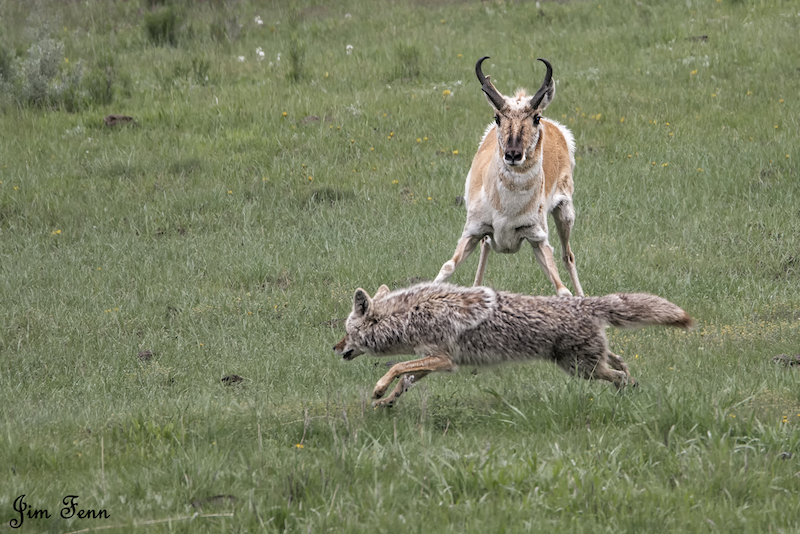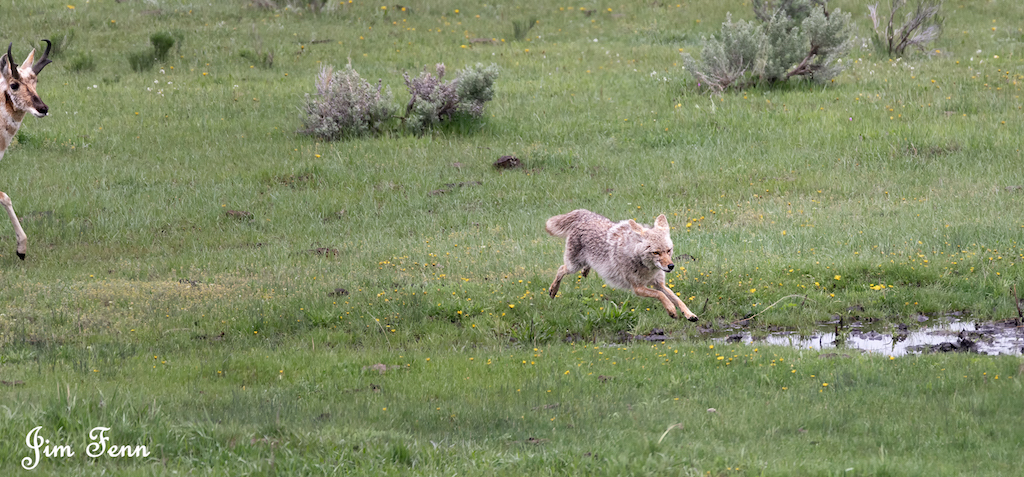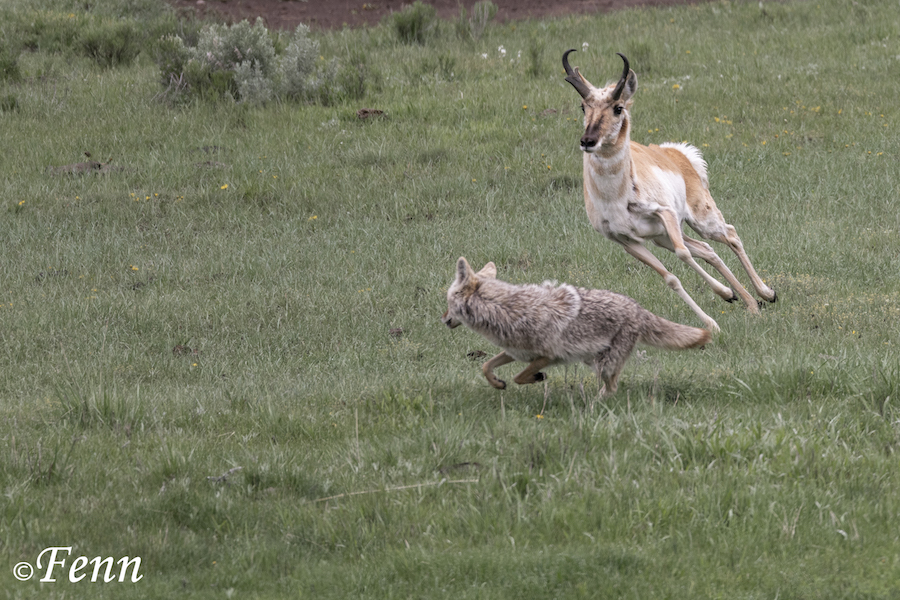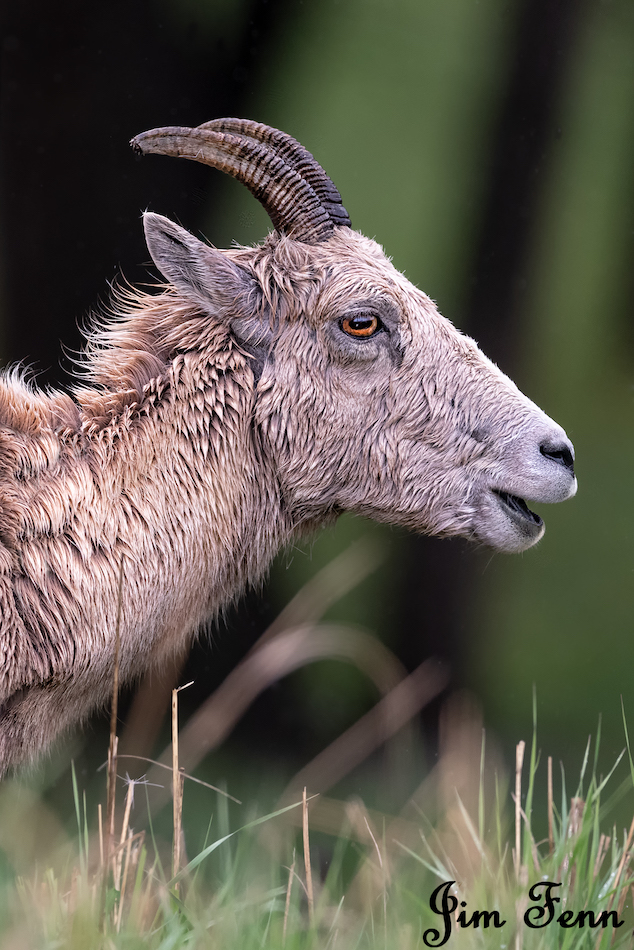7 Days Photographing the Most Majestic Parks in America
Yellowstone National Park & Grand Teton National Park in Wyoming
A Reader's Special Report
IN THE SEVEN DAYS LEADING UP TO MEMORIAL DAY LUCK WAS WITH US. WE SAW AND PHOTOGRAPHED THE WILDLIFE OF AMERICA'S TWO MOST MAGNIFICENT NATIONAL PARKS. IMAGE: ©JIM FENNESSY
Jim Fennessy joins our series of reader’s wildlife adventure reporters. Have YOU been on a wildlife adventure? Tell us about it.
✓ Trip Tips
What: Wildlife Photography trip
Where: Grand Teton National Park, and Yellowstone National Park, Wyoming
Who: Adults, or families and children with alternate itineraries.
When: Spring, and all year
How: Fly then drive. Closest airport: Yellowstone, West Yellowstone, Montana
Tips: Prepare for all 4 seasons
Why Responsible: Fees pay for land & wildlife conservation and rangers, tourist income is base of local small business economies.
Jim Fennessy is a retired State Trooper and an active lawyer with two children and a love of wildlife and ethical wildlife photography. We are excited that Jim agreed to share his trip with all of us.
My Friend & I and Our (Lucky) Wild Photographic Journey
The opportunities for sighting wildlife are of course somewhat random – the luck is either with you, or it’s not. And since the chances are seasonally based, no timing can be perfect, but ours was pretty good.
In the days leading up to Memorial Day 2018, a friend and I - both weekend amateur photographers - spent seven days exploring and photographing two of the most majestic national parks in the country: Yellowstone and Grand Teton in Wyoming.
YOUNG PRONGHORNS SPARRING FOR DOMINANCE IN THE HERD. YELLOWSTONE NATIONAL PARK, WYOMING. IMAGE: JIM FENNESSY
The parks are contiguous, with Yellowstone immediately north of Grand Teton. We split our time evenly between them, staying in Jackson Hole, Wyoming while photographing in the Grand Tetons, and in Gardner, Montana when concentrating on Yellowstone.
It was my first trip to either of these parks, and we didn’t have a guide. We a rented four-wheel drive vehicle and had some great luck with wildlife and landscape photography opportunities.
GRAND TETON NATIONAL PARK, WYOMING. SUNRISE ON THE MOUNTAIN REFLECTING INTO A BEAVER POND. IMAGE: JIM FENNESSY
Four Seasons in One Week and Babies Everywhere
THIS BLACK BEAR CUB ON BREAK FROM CLIMBING ON EVERYTHING CHEWS ON A PINE CONE. ITS EXHAUSTED-LOOKING MOTHER KEPT AN EYE ON IT NEAR-BY. YELLOWSTONE NATIONAL PARK. IMAGE: JIM FENNESSY.
NEW CUB OF FAMOUS 22-YEAR OLD GRIZZLY #399 IN THE GRAND TETON NATIONAL PARK. IMAGE: JIM FENNESSY
Many of the roadways and areas we explored had just opened up for the season after the winter and spring snows, so we had a lot of space to explore. But, depending on the time of day and altitude, we also experienced four seasons worth of weather in one week.
The rivers were fast and rushing with snowmelt, and young baby wildlife was everywhere around us.
I particularly enjoyed photographing the sweet and playful interactions between mother and young, including grizzlies, black bear, moose, and badgers.
BADGER LOVE. A MOM BADGER HAS A QUIET MOMENT WITH ONE OF THIS SPRING'S LITTER. YELLOWSTONE NATIONAL PARK, WYOMING IMAGE: JIM FENNESSY
The downside of our timing (besides some Memorial Day crowds) was that the deer-type animals - moose, elk, deer - don’t look their best in late spring, as they are shedding their winter coats and just starting to grow in their velvet antlers. But that only gives me more reason to return to Yellowstone in the winter, though at that time the bears will be hibernating.
a CINNAMON BLACK BEAR, A BLACK BEAR SUBSPECIES ARE COMMON IN THE WEST, THEY HAVE LARGER EARS AND SMALLER CLAWS THAN GRIZZLIES. GRAND TETON NATIONAL PARK, WYOMING IMAGE: ©JIM FENNESSY
The Camera Equipment I Carried -
And What I Wished I'd Had
I SWITCHED TO LIGHTER (CAMERA) GEAR TO HIKE UP YELLOWSTONE'S MOUNTAINS FOR BIG HORN SHEEP IN DEEP SNOW. IMAGE: ©JIM FENNESSY
Most of my wildlife images were shot handheld with a Nikon D850, 600mm f4 and 1.4 teleconverter (when there were enough light and distance for a TC).
I switched to lighter gear (Nikon D500 and a 70-200 lens) to hike up the mountains for bighorns in deep snow. In retrospect, I should have carried a longer zoom lens for the mountain hiking. The 24-70mm lens on a full frame camera was perfect for the mountain landscapes.
I captured images of grizzly bears, including the famous Grizzly #399 and her cubs, and Blondie and her cubs, and more distant grizzlies.
I photographed several black bears also with cubs, and a cinnamon black bear, several moose, several coyotes (including coyotes sparring with pronghorn), an adorable badger family, porcupine, bighorn sheep on a snowy mountaintop, American bison, elk, mule deer, fox, sandhill cranes, and lots of other birds.
GRIZZLY MOM CROSSING A STREAM IN THE GRAND TETON NATIONAL PARK, WYOMING. NOTE THE "DENT" IN HER FOREHEAD - BLACK BEARS DO NOT HAVE IT. IMAGE: JIM FENNESSY
Meeting Famous Grizzly Bear #399
Grizzly #399 of the Pilgrim Creek area lived up to the renown she has built wowing tourists and wildlife enthusiasts for the last 22 years. She grazed and played with her energetic cubs alongside the road in the Grand Tetons every day, as her cubs stole the orange traffic cones that the rangers used to keep people away from them.
MOUTON BARN, THE GRAND TETON NATIONAL PARK, WWYOMING AT SUNRISE. A CHORUS OF COYOTES HOWLED ALL AROUND US. THIS IS MY HEAVEN. IMAGE: JIM FENNESSY
IN YELLOWSTON NATIONAL PARK, WYOMING, COYOTE SCOPING OUT PRONGHORN. ALL THE PRONGHORN LIVED TO RUN ANOTHER DAY. IMAGE: ©JIM FENNESSY
My Own Version of Heaven
I had the thrill of watching wolves stalking bison in the hills above Yellowstone’s Lamar Valley, but the distance and atmosphere were too great to capture publishable quality images of these magnificent wolves. Nevertheless, the experience was priceless, whether or not it produced good photography.
Similarly, while photographing the Moulton Barn in the Grand Tetons at sunrise, there was a chorus of coyote howls arising around us from every direction. If everyone gets their own version of heaven, this would be my choice.
Be Careful and Respectful of Animals!
As a cautionary note for people exploring wildlife areas without guides, please be careful and respectful of the animals. Already this season in Yellowstone, two people in separate incidents have been gored by American Bison, and there were two additional instances of people bitten by moose.
Moose mothers are incredibly protective of their young, and they will attack you if you get too close to their babies. All of my moose family shots were from a respectable distance, using teleconverters on my 600 f4 lens, and then some additional cropping.
CLOSE-UP OF A PORCUPINE IN GRAND TETON NATIONAL PARK. TAKING THE IMAGE IN BALCK & WHILE ALLOWED FOR A BETTER IMAGE AS THE HEMLOCK TREE GAVE TOO MUCH GREEN CONCEALMENT FOR A DECENT IMAGE. IMAGE: JIM FENNESSY
Get the Close-up Shot From a Distance
Bison are also enormous and dangerous. I photographed bison knocking down solid fence posts while innocently using them as scratching posts. Their power is fantastic, and I wouldn’t have wanted to be in the position of those crushed fences.
Every animal has its own comfort level and personal space requirement, erring on the side of caution with physical proximity (to wildlife) is essential. Moreover, a close bison might charge you if it is spooked by some other close or loud person or vehicle.
WE WATCHED INCREDIBLY POWERFUL AMERICAN BISON IN YELLOWSTONE NATIONAL PARK, DESTROY THESE FENCES BY INNOCENTLY USING THEM AS SCRATCHING POSTS. IMAGE: ©JIM FENNESSY
When I did get my close up shot of a bison (the term "close" is relative when you are shooting a large animal at 900mm), I was kneeling quietly and perfectly stationary before the bison approached me. There weren’t any other people around who might spook the bison, and its body language was reassuring (it never stopped eating as it approached me). However tempting the photography opportunity might seem, follow the national park guidelines regarding wild animals.
I WAS A GOOD DISTANCE AWAY, WATCHING ITS BODY LANGUAGE AND FOLLOWING PARK GUIDELINES WHEN I TOOK MY CLOSE-UP SHOTS OF THE BISON.GRAND TETAON NATIONAL PARK, WYOMING. IMAGE: ©JIM FENNESSY
The Beauty Surpassed Anything I have Ever Experienced
The wildlife experiences in both national parks exceeded my expectations, and the mountain beauty of the Grand Teton landscapes surpassed anything I have ever experienced. I know that I will be returning to Yellowstone and the Grand Tetons to experience these parks in all of their seasons. In the interim, I have these photographs to remember an amazing week.
GRAND TETON NATIONAL PARK, WYOMING, THE WILDLIFE EXPERIENCES IN BOTH PARKS AND THE MOUNTAIN BEAUTY SURPASSED ANYTHING I HAVE EVER EXPERIENCED. I WILL BE BACK. IMAGE: ©JIM FENNESSY
Thanks for sharing, Jim! We look forward to your next photographic journey!
Have you got a story to share? Contact us!
More
How to take Your Wife to See Beaches, Bears & Wild Horses North Carolina's Outer Banks & Alligator National Wildlife Refuge By Joe Gliozzo
Photographing Black Bear in the Rain Cade's Cove, Tennessee By Robert Wallace
8 Magic Places to See Wolves in the Wild. The US, Canadian Arctic, Brazil, and Europe.
By Roberta Kravette
Slippery Ann's Amazing Bugling Elk, Charles M. Russel National Wildlife Refuge, Montana By Roberta Kravette














